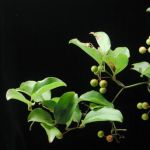| Common Name: |
China Root |
| Botanical Name: |
Smilax china |
| Genus: |
Smilax |
| Family: |
Smilacaceae |
| Location: |
Japan, China, and Korea |
| Cultivation: |
Well-drained soil in sun or partial shade. |
| Propagation: |
By seed sown in autumn; by division in autumn or spring; by separation of suckers in spring. |
| Harvest: |
Roots and rhizomes are lifted by severing larger roots near the crown, leaving smaller roots to increase. They are dried for use in decoctions, elixirs, liquid extracts, and powders. Leaves are picked during the growing season and used fresh or dried. |
| Height: |
5m (15ft) |
| Width: |
Indefinite |
| Hardiness: |
Z7-10 |
| Parts Used: |
Tuberous rhizomes |
| Properties: |
A cooling, slightly bitter, alterative herb that has antibiotic, anti-inflammatory, diuretic, and anti-rheumatic properties. |
| Medicinal Uses: |
Internally for rheumatoid arthritis, gout, syphilis, skin disorders (including psoriasis), enteritis, urinary tract infections, jaundice, skin ulcers, boils, abscesses, and various kinds of cancer. |
| Culinary Uses: |
Leaves, young shoots, and roots are eaten as a vegetable. Leaves can be used for tea. |
| Bibliography: |
Encylopedia of Herbs by Deni Brown Copyright ©: 1995, 2001 Dorling Kindersley Limited pg 370.
|

